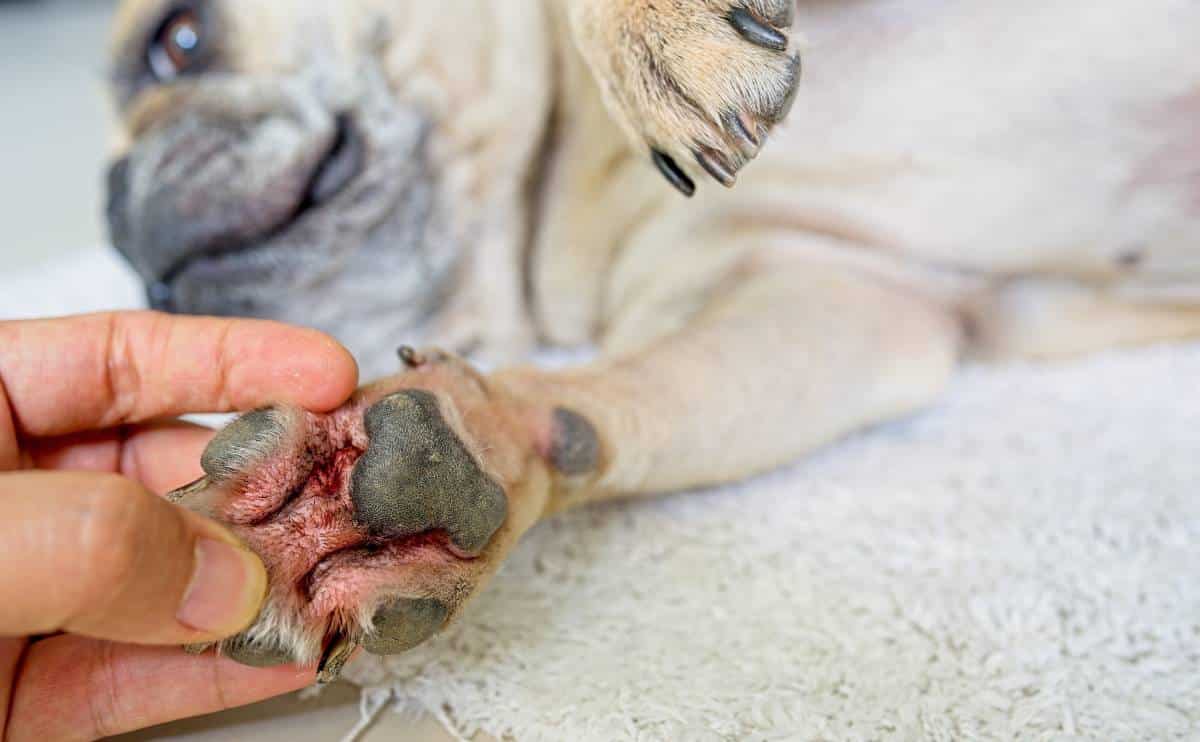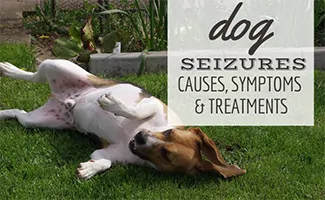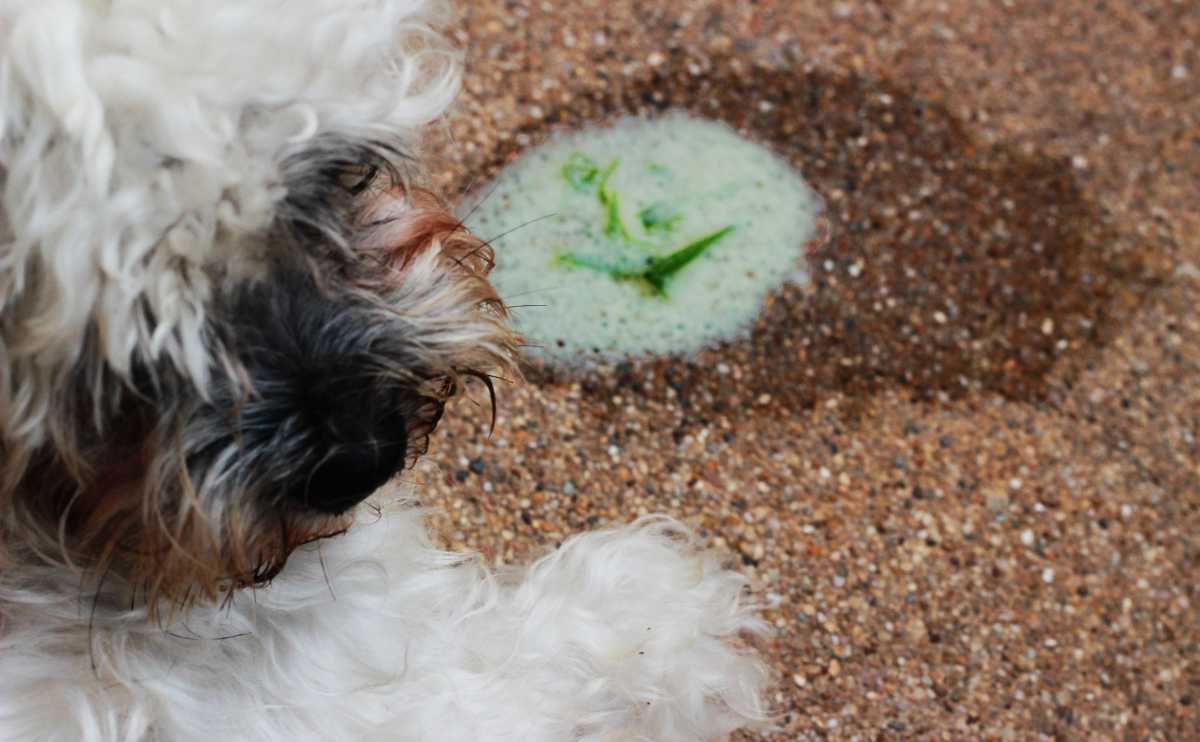Your Dog’s Drooling Like a Faucet – Here’s What It Actually Means
When you purchase through links on our site, we may earn a commission. Here’s how it works.
Your dog just turned into a leaky faucet, and you didn’t even cook bacon. If the slobber is sudden, one-sided, foamy, or just way more than usual, it could mean anything from a stuck snack to a full-on vet emergency.
Table of Contents
I’ll decode the drool, fast, starting with the signs you should never ignore.

Dog Drooling Like Crazy? Here’s What It Means
So your dog just unleashed a full-on slobber tsunami and you’re wondering if it’s totally normal… or a total emergency.
Here’s the fast answer: Some dogs drool a lot. But when it changes suddenly in how much, how it looks, or when it happens, it usually means something’s up. So, is it normal or time to panic?
| Drool Situation | Should You Worry? |
|---|---|
| Mealtime puddle | Totally normal. Especially if bacon was involved. |
| Sleepy drool from a nap | No problem. Dog dreams hit hard. |
| Ropey, thick, or smelly drool | Yes. Call the vet. |
| One-sided, foamy, or sudden drool | Definitely not normal. |
| Drooling a lot and acting weird (shaking, whining) | Vet. Now. |
Quick takeaway: If your dog is suddenly drooling a lot and seems off, even just a little, it’s better to check than to guess.
Normal Slobber vs. Red Flag Drool
Let’s get this out of the way: some drooling is completely normal. Certain breeds are practically born with built-in faucets, and even the driest dog will drool a little when food, stress, or excitement kicks in.
But there’s a big difference between “my dog’s hungry” drool… and “something’s wrong” drool.
What’s Normal Dog Drooling?
Most of our canine companions drool occasionally. As long as your dog is drooling clear slime, it clears up fairly quickly, and your pup isn’t showing any signs of distress, this type of drooling is completely harmless.
- Happens around mealtime or food smells
- Common in breeds like Bulldogs, Mastiffs, and Saint Bernards
- Occurs while napping or yawning
- Shows up briefly during excitement or play
- Mild drooling during car rides or light stress
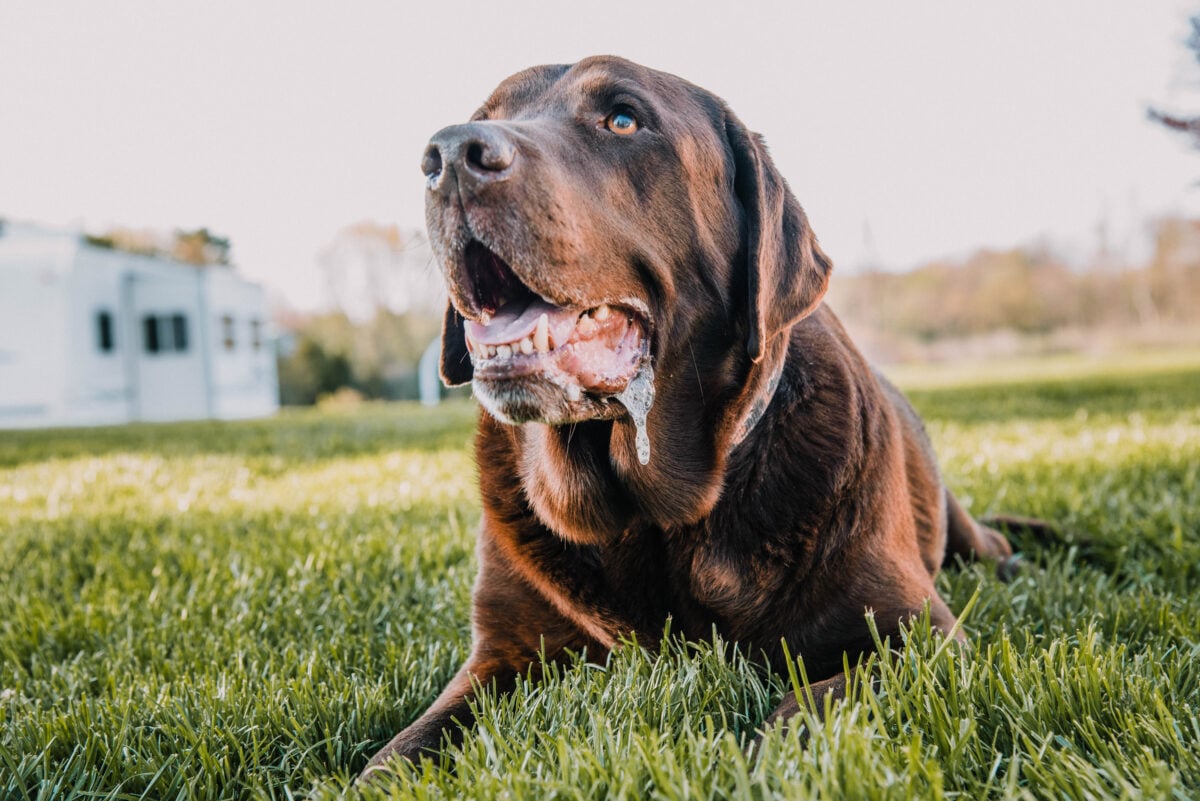
When Drooling Means Trouble
- Thick, ropey, or unusually smelly saliva
- One-sided drool, especially with head tilting or pawing at the mouth
- Foaming at the mouth or drool mixed with blood
- Sudden onset without any clear trigger
- Drooling alongside whining, pacing, or unusual behavior
If your dog is drooling more than usual and acting even slightly off, it’s worth checking their mouth and watching for changes.
Foamy, One-Sided, or Smelly? 3 Danger Signs
Some drool just means dinner smells amazing. But if your dog suddenly has thick, weird-looking, or gross-smelling slobber, something could be seriously wrong. Here are three major red flags:
1. Foamy or White Drool
This isn’t just excitement or thirst. Foamy drool can be a sign of:
- Toxin ingestion (especially toads, chemicals, or plants)
- Nausea or gastrointestinal distress
- Oral ulcers or mouth pain
- In rare cases, seizures or neurological issues
If the foam is accompanied by tremors, vomiting, or collapse, call your vet or an emergency clinic immediately.
2. One-Sided Drooling
This often points to a problem inside your dog’s mouth:
- Broken or abscessed tooth
- Something stuck in the gums or throat (bone, stick, toy)
- Nerve damage or oral trauma
Dogs with one-sided drool may also paw at their mouth or tilt their head slightly.
3. Bad-Smelling Slobber
Normal dog drool doesn’t stink. If it smells rotten, metallic, or like infection:
- It could be an infected wound or abscess
- A decaying tooth or gum disease
- Or even something lodged and rotting in the mouth
Bottom line: If the drool looks different, smells bad, or only comes out one side, it’s not just slobber, it’s a signal.
7 Worrying Reasons Your Dog’s Suddenly Drooling
So far, I’ve covered what normal dog drool looks like and when it clearly isn’t. But what about those in-between moments where your dog suddenly starts drooling for no obvious reason?
Here are seven lesser-known causes of excessive drooling in dogs that often catch owners off guard:
1. Gastrointestinal Trouble
Upset stomachs, acid reflux, or more serious digestive issues can trigger drooling, especially if your dog is restless or licking their lips a lot.
Several gastrointestinal (GI) disorders can cause hypersalivation with varying degrees of severity. Some conditions like inflammation of the esophagus (esophagitis), gastric ulcers, GI cancers, and inflammatory bowel disease require a vet diagnosis and treatment, but aren’t immediately life-threatening.
Intestinal blockage is fairly common in dogs because they love to chew on foreign objects, which they can end up swallowing. In addition to increased salivation, a GI obstruction typically causes vomiting without the ability to defecate, loss of appetite, weakness, and signs of restlessness.
As soon as you suspect your pup could have an intestinal blockage, seek veterinary care promptly. Left untreated, it can cause severe dehydration, intestinal rupture, and even death.
Clue: Watch for gagging, swallowing motions, or lack of appetite along with the drool.
2. Insect Stings or Oral Irritants
A bee sting, spider bite, or even licking something spicy or irritating can lead to sudden, excessive drooling.
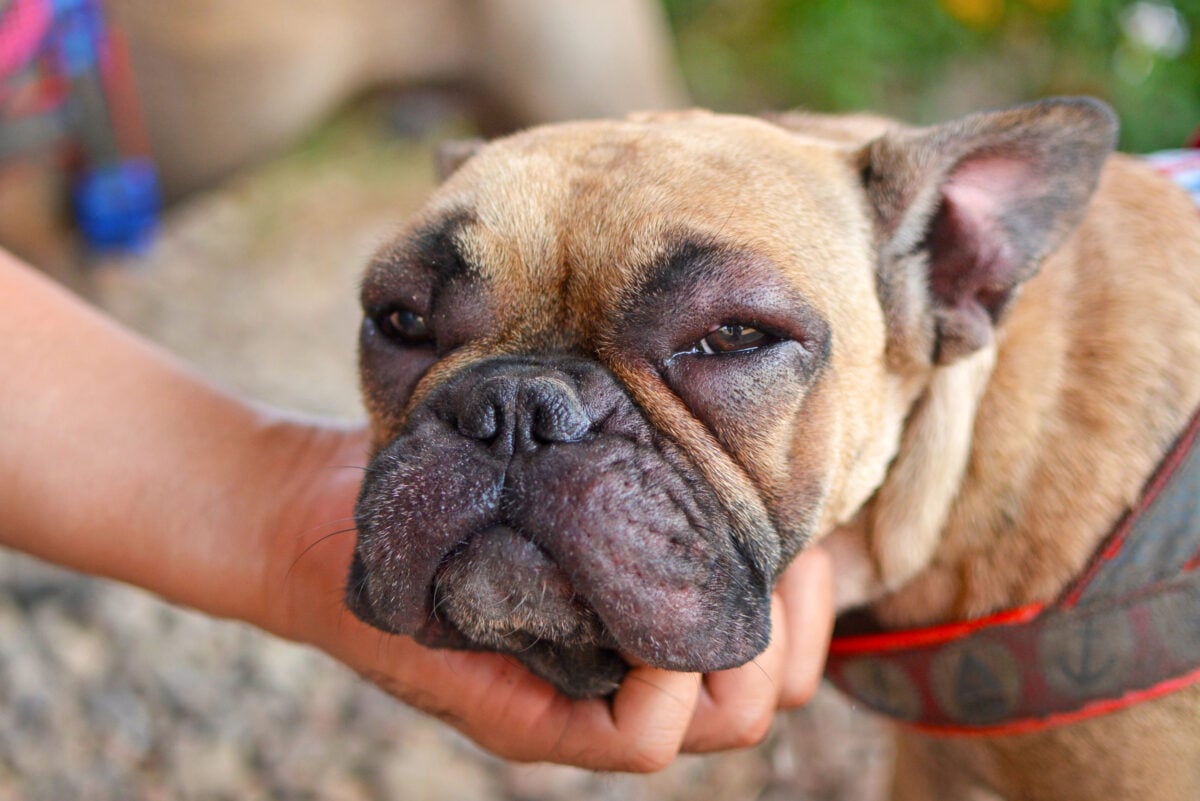
Clue: Swelling around the lips or face, sudden distress, or drooling right after being outside.
3. Toxins
Ingesting a toxic substance, like poisonous plants, some human foods, household cleaning products, or yard chemicals, often causes sudden excessive salivation in dogs.
Other signs of dog poisoning include foamy drool, vomiting, diarrhea, lethargy, decreased appetite, and lack of coordination. If you think your dog ate something toxic, contact your vet immediately.
If you can’t reach your vet, contact an emergency vet clinic or poison control for dogs. You can reach the Pet Poison Helpline.
Expert Tip: Some ways you can pet-proof your home and yard to minimize poisoning include using dog-safe yard products, cleaning agents, and pest control. Don’t give your furry friend table scraps or human food treats until you familiarize yourself with which foods are toxic to dogs.
4. Pain That’s Hard to See
Neck pain, sore throat, or jaw injuries can make it hurt to swallow, so the saliva just pools and drips.
Clue: If your dog is drooling but still seems alert, try gently checking for signs of tenderness or swelling under the jaw or neck.
5. Neurological Conditions
In rare cases, nerve damage or brain inflammation can mess with your dog’s ability to swallow normally, leading to constant drooling.
Clue: This is usually paired with other signs like stumbling, head tilt, or unusual eye movement.
6. Mouth & Throat Problems
Trauma or an injury to the mouth or throat, or a foreign object that’s lodged in the mouth or throat (e.g., a piece of bone) could be the reason your dog is suddenly excessively drooling.
Typically, in these situations, your pup will show signs of distress, such as shaking his head and pawing at his mouth. Oral lumps and cancers can also cause hypersalivation as well as difficulty eating and drinking.
7. Dental Issues
Tooth infections, a fractured tooth, tartar buildup, and gum disease can all cause excessive drooling. If your pup’s slobbering is due to dental problems, their drool may appear slightly bloody or brown and may have a rank odor.
Dental issues may also cause your dog to paw at their mouth, have difficulty chewing, or lose their appetite.
Unfortunately, gum disease is quite common in dogs over three years old. Veterinarians recommend brushing your pup’s teeth daily to keep their gums and teeth as healthy as possible.

Giving your furry friend dental chews, tooth-safe rawhide alternative treats, and chew toys regularly can also help control tartar buildup. Just be sure to avoid giving your dog natural bones because they can cause tooth fractures.
Quick Takeaway: If your dog is suddenly drooling a lot and acting even slightly strange, don’t write it off. Weird causes can escalate fast.
Other Conditions
Drooling is a symptom associated with several serious diseases and other health conditions. Some of these include:
- Kidney disease
- Liver disease
- Cancer or tumor in the mouth
- Rabies
- After suffering a seizure
- Sinus infections
- Facial nerve paralysis
What’s Stuck in Their Mouth?
If your dog suddenly starts drooling, and especially if it’s only coming from one side, the first place to check is their mouth.
Because sometimes, the reason isn’t a health condition at all. It’s a sock. Or a chunk of stick. Or that LEGO your kid lost under the couch.
Common Things Dogs Get Stuck in Their Mouths
- Small bones (especially cooked or brittle ones)
- Sticks or wood splinters lodged between teeth
- Rope toy fibers or strings
- Food debris or treats stuck in the roof of the mouth
- Teeth that are cracked, loose, or abscessed
Dogs can’t always paw things loose. Instead, they may:
- Drool excessively (often on one side)
- Avoid chewing on one side of their mouth
- Gag or make odd licking motions
- Whine, scratch at their muzzle, or suddenly refuse food
Tip: If your dog lets you, gently open their mouth and look for swelling, redness, or visible objects. If they resist or you’re unsure, get your vet to check it safely.
When It’s Not Just Stuck, But Infected
If something has been stuck for too long, it can lead to:
- Gum infections
- Oral ulcers
- Tooth root abscesses
- Foul-smelling saliva and visible swelling
At that point, drooling isn’t just a symptom; it’s your dog’s way of waving a red flag. And this is something that needs immediate veterinary attention.
Is It Poison? These 5 Things Trigger Slobber
If your dog starts drooling suddenly and the timing is right after they were outside, near trash, or somewhere they shouldn’t be, it could be a reaction to something toxic.
And in many of these cases, drooling is the very first warning sign:
1. Toads: Yep, toads. Certain toad species (like the Cane toad and the Colorado river toad) secrete a toxin through their skin that causes dogs to foam, drool, and panic within minutes of licking or biting.
Clue: Your dog was just outside, now drooling heavily, pawing at their mouth, and acting “off.”
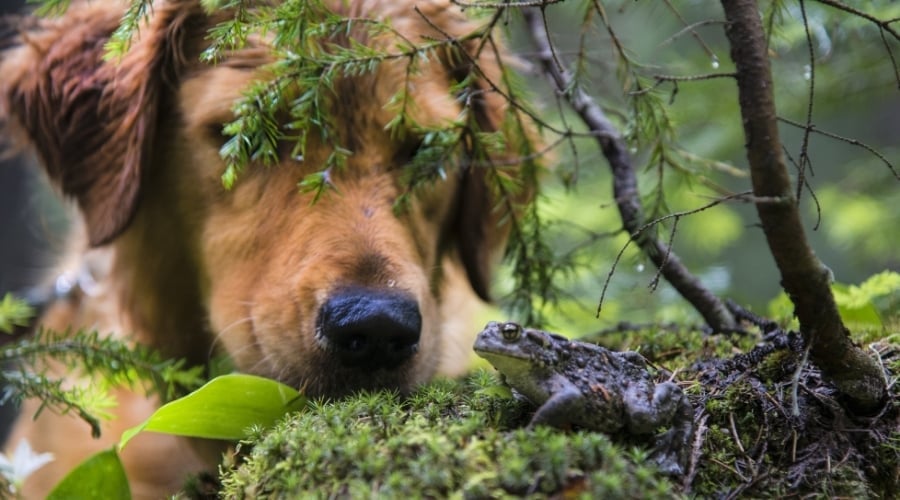
2. Household Cleaning Products: Bleach, detergents, and even some disinfectant wipes can cause chemical burns in the mouth or throat if licked.
Clue: White foamy drool, excessive licking, refusing to eat.
3. Trash & Spoiled Food: Dogs love garbage. But rancid meat, moldy food, or grease-soaked packaging can trigger nausea, GI upset, and toxin exposure.
Clue: Drooling + vomiting, diarrhea, or pacing.
4. Plants & Flowers: Sago palm, tulips, lilies, and many common houseplants can cause drooling, oral pain, or worse.
Clue: You have plants + a curious pup + a drool puddle.
5. Pesticides or Rodent Bait: These are extremely dangerous and often fatal without rapid treatment.
Clue: Drooling paired with shaking, staggering, or vomiting = emergency vet trip now.
Quick Takeaway: If drooling starts suddenly and your dog was just exploring, sniffing, or chewing on something unfamiliar, don’t wait. Call your vet or poison control immediately.
Bloated Belly + Slobber? Time to Call the Vet, Fast
If your dog is drooling a lot, acting strange, and also looks bloated, restless, or unable to lie down comfortably, get to a vet immediately.
This might be more than a bad bellyache. It could be gastric dilatation-volvulus (GDV), commonly called bloat, a fast-moving, life-threatening condition that requires emergency surgery.
What Is GDV (a.k.a. Bloat)?
GDV happens when a dog’s stomach fills with gas and twists, cutting off blood flow. It can happen suddenly, often after eating or exercising, and causes pain, pressure, and panic in the dog’s body. Drooling is one of the earliest signs.
Signs of GDV to Watch For
- Excessive drooling, often thick and ropey
- Swollen, tight belly (feels like a drum)
- Unproductive vomiting (trying to throw up, but nothing comes out)
- Pacing, restlessness, whining
- Heavy panting or shallow breathing
- Sudden collapse or weakness
High-Risk Dogs:
- Large, deep-chested breeds (Great Danes, Weimaraners, Dobermans, German Shepherds)
- Dogs who eat quickly or only one large meal per day
- Dogs that exercise right after eating
Remember: GDV can be fatal in hours. If your dog shows these symptoms, skip Google and go straight to the emergency vet.
Vet Visit Coming? It Could Be Anxiety
Not every drool puddle means your dog is sick or in danger. Sometimes… they’re just freaking out.
Dogs drool when they’re nervous, just like people sweat. If your pup starts drooling more than usual before the vet, during thunderstorms, or even on car rides, anxiety could be the culprit.
When Stress = Slobber
Look for these common anxiety triggers:
- Riding in the car
- Hearing fireworks or loud noises
- Being left alone (separation anxiety)
- New environments or people
- Visits to the groomer or vet
Symptoms may include:
- Excessive drooling
- Lip licking or yawning
- Panting or trembling
- Pacing or hiding
- Clingy or avoidant behavior
Key difference: Stress drool tends to be clear, thin, and short-lived. It often stops once the stressful event is over.
But if the drooling continues after things calm down, or is paired with symptoms like vomiting or lethargy, it’s worth ruling out a medical cause.
Here are a few ways you can calm anxiety-induced drooling:
- Try calming supplements or pheromone sprays (ask your vet)
- Use a crate or comfort item during car rides
- Practice desensitization with short, no-vet car trips
- Avoid feeding right before stressful events to reduce nausea
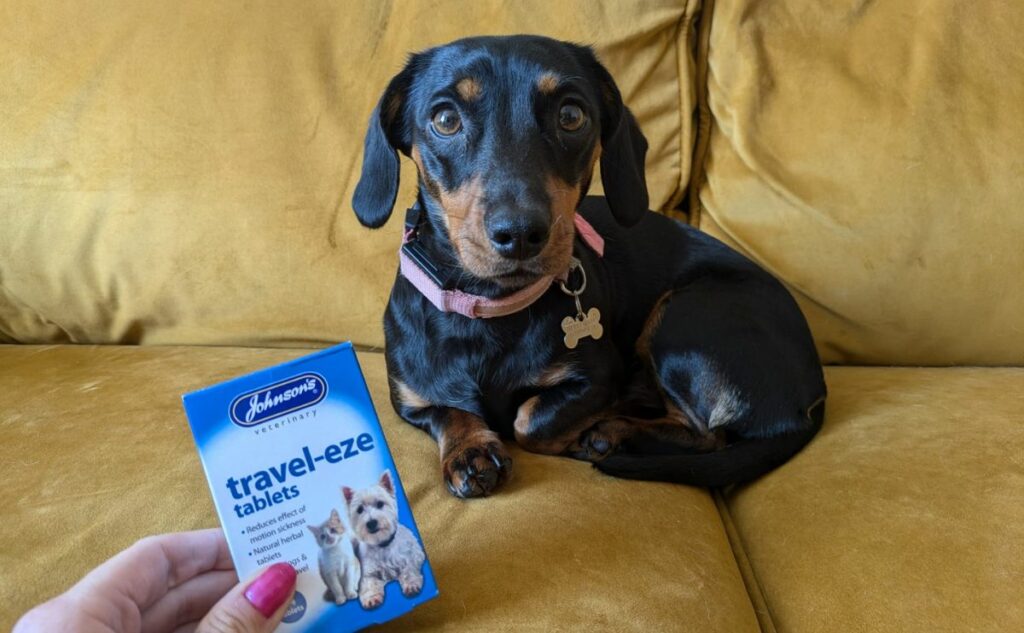
The only time my dog, Chips, ever drools is during car rides – classic travel sickness. When she was a puppy, even short trips meant soaked seat belts and puddles on the floor mats.
Over time, it’s eased a bit, but I’ve learned to manage it: no meals before long trips and a travel-sickness tablet when needed. When I do both, she almost never drools anymore.
Drooling After Walks or Play? Here’s What’s Normal vs. Not
Your dog just finished zooming around the yard or chasing the ball at the park, and now they’re standing there, tongue out, panting, and drooling like crazy.
So, is this just post-play slobber… or a sign of something more serious?
When Drooling After Exercise Is Normal
Mild, short-term drooling during or after activity is usually harmless, especially if your dog is:
- Panting to cool down
- Excited or overstimulated
- One of the naturally slobbery breeds (like a Boxer or Saint Bernard)
- Drooling clear saliva and otherwise acting normal
Some dogs even drool a bit more before a walk out of excitement or anticipation.
When It Might Be a Red Flag
Excessive drooling after a long walk or spending time in the hot sun could mean your pup is suffering from heat stroke. If your dog’s drooling seems excessive and comes with any of the following, pay close attention:
- Heavy or rapid panting that doesn’t ease with rest
- Lethargy, wobbling, or collapsing after exercise
- Hot weather or sun exposure just before symptoms
- Drool that’s foamy, thick, or smells odd
- A bloated belly or unproductive retching (potential bloat)
This could signal:
- Heat exhaustion or early heatstroke
- Nausea from overexertion
- A foreign object picked up during the walk
- A more serious internal issue, especially in flat-faced or older dogs
Dogs are more susceptible to overheating than humans, especially elderly pups, brachycephalic (flat-faced) breeds, and those with thick fur. Other signs of heat stroke include heavy panting, difficulty breathing, vomiting, lethargy, disorientation, and collapsing.
If you suspect your dog is experiencing heat stroke, take them to a cool location, give them water to drink, and place cool, wet towels on them. It’s crucial to treat this as a life-threatening emergency and seek veterinary care immediately.
Rule of Thumb: If the drool doesn’t stop within a few minutes after rest or your dog just doesn’t seem right, call your vet.
What Breeds Drool The Most?
Some dogs were simply built to drool.
If you’ve got one of the classic slobber breeds, a little extra wetness is par for the course, especially after meals, play, or naps. Their anatomy just doesn’t hold saliva in the same way as other dogs.
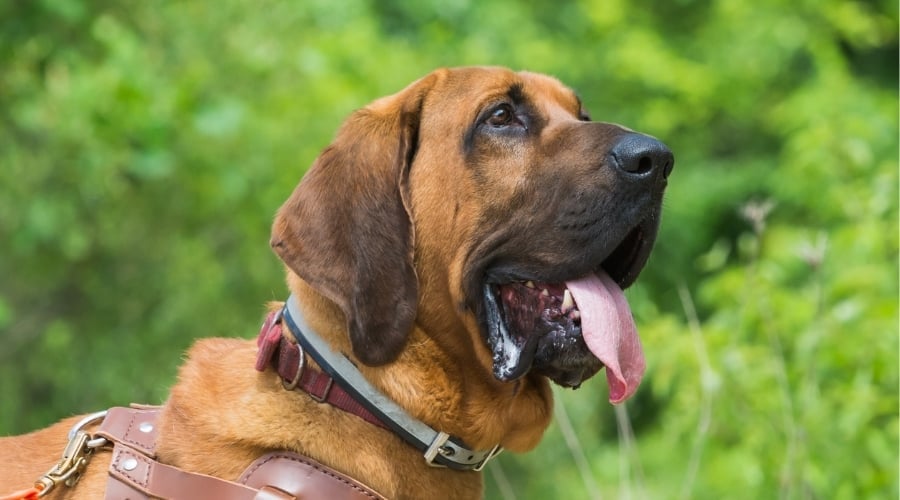
Dog Breeds That Drool a Lot
- Saint Bernards
- Newfoundlands
- Mastiffs (English, Bullmastiff, Neapolitan)
- Bloodhounds
- Boxers
- Bulldogs (English, French)
- Great Danes
- Basset Hounds
These dogs tend to have loose jowls, deep lips, and lots of extra skin around the mouth, all of which make it easier for drool to escape.
If your dog is one of these breeds and seems otherwise healthy and happy, don’t panic over a little puddle near their food bowl or water dish.
But Even Slobber Champs Can Overdo It
Just because your dog is “normally drooly” doesn’t mean all drooling is harmless. You still want to look out for:
- Sudden changes in how much or how often they drool
- One-sided drooling
- Blood, foam, or a bad smell
- Drooling with behavior changes like whining or withdrawal
Even natural droolers can develop mouth injuries, infections, or more serious issues. So keep an eye on their normal baseline and trust your gut when something seems off. If you have one of these super salivators, you’re likely attuned to what a normal amount of drool is for your dog.
Puppy Drooling a Lot? 4 Common Reasons
New puppy in the house and suddenly dealing with a drool situation?
In most cases, puppy drooling is completely normal, especially during certain developmental stages. But just like with adult dogs, it depends on the context. It could be:
- Teething: Just like human babies, puppies produce more saliva when their adult teeth start pushing in.
- Excitement: Puppies get hyped easily, especially around food or play, and may drool a little in the process.
- Breed tendencies: If your pup is a natural slobber breed (like a Boxer or Mastiff), some early-stage drool is expected.
- Crate or car anxiety: New experiences can trigger stress-based drooling in sensitive pups.
If your puppy is drooling but eating, playing, and acting normally, chances are it’s just part of growing up.
When Puppy Drooling Might Be a Problem
Keep an eye out for these red flags:
- Drool, that’s one-sided or bloody
- Excessive lip licking or pawing at the face
- Drooling paired with vomiting, diarrhea, or lethargy
- A sudden change in drooling behavior (e.g., not drooly, then very drooly all day)
- Drooling after chewing on unknown objects, plants, or toys
Puppies love to chew everything, and that includes things that don’t belong in their mouths, so foreign object ingestion is a real concern.
If anything seems off or persistent, don’t wait to check in with your vet.
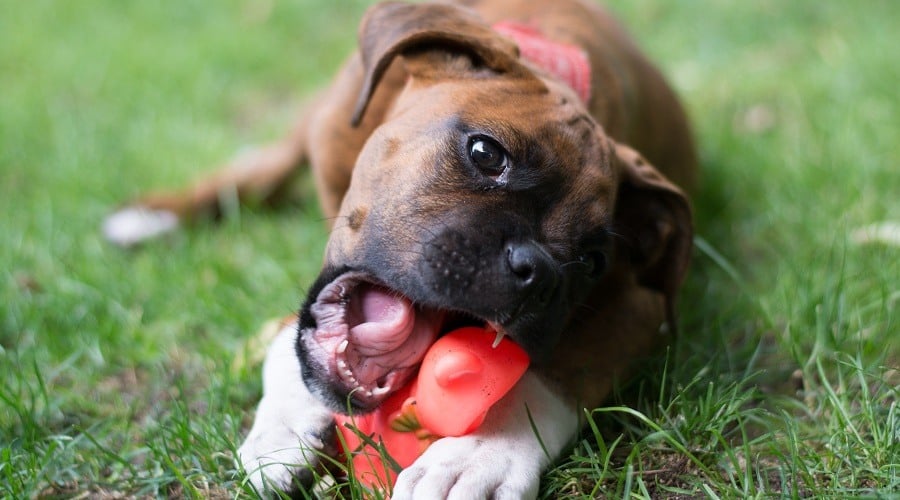
Dog Drooling & Acting Weird? When to Call the Vet
If your dog is drooling a lot and just doesn’t seem right, trust that instinct. Excessive drooling paired with strange behavior can signal something more serious than a messy mouth.
6 Signs It’s Time to Call the Vet
- Drooling alongside lethargy or weakness
- Pacing, whining, or restlessness that won’t stop
- Refusing food or water
- Vomiting or gagging without a clear cause
- Shaking, trembling, or stiffness
- Drooling with a bloated belly, confusion, or collapse
Additionally, when drooling is paired with any kind of behavior change, it’s your dog’s way of telling you something is very wrong.
What to Expect at the Vet
Your vet may:
- Examine your dog’s mouth, teeth, and throat
- Take X-rays or run bloodwork
- Check for signs of poisoning or infection
- Treat dehydration or nausea if needed
Most cases of drooling are treatable, but early attention makes a big difference in how serious it becomes.
When to Wait, Watch, or Wipe: What You Can Do at Home
Not every case of drooling means a midnight vet trip. Sometimes your dog just needs a break, a bowl of water, and a clean towel.
Here’s how to tell when you can safely wait and what you can do in the meantime.
When It’s Okay to Wait and Watch
You can usually monitor at home if:
- Your dog is alert, playful, and otherwise normal
- The drooling started after something obvious (a walk, a treat, excitement)
- The saliva is clear and not excessive
- There’s no vomiting, bloating, or behavior change
Keep an eye on them for the next few hours. If the drooling slows down and your dog seems fine, you probably avoided a scare. But, trust your instincts; you know what’s normal for your dog.
Simple At-Home Tips to Help a Drooling Dog
- Check the mouth: Look for stuck food, toys, or splinters (if your dog lets you).
- Hydrate: Offer cool, clean water – sometimes saliva builds up from dry mouth or mild nausea.
- Cool them down: Move to shade or indoors if it’s hot.
- Clean the area: Gently wipe away drool to prevent skin irritation under the chin.
- Ease the stomach: Skip rich treats or big meals until they’re back to normal.
- Track changes: Note when the drooling started, what they were doing, and how long it lasted, as this helps your vet if symptoms return.
Is That Even Drool? 3 Things It Could Be Instead
Not every wet spot on your dog’s chin is just drool. Sometimes what looks like saliva is actually a clue to something else going on. Here are a few possibilities worth knowing about.
1. Foam or Mucus
If your dog’s “drool” looks bubbly or white, it may not be saliva. It could be stomach fluid or foam from mild nausea or acid reflux.
This often happens:
- First thing in the morning, before breakfast
- After eating grass or skipping a meal
- During long car rides
If it passes quickly and your dog seems normal afterward, it’s probably just mild stomach upset. But persistent foamy drool with vomiting or lack of appetite can point to something more serious.
2. Regurgitated Water or Vomit
Sometimes, dogs bring up small amounts of water or bile that mix with saliva and look like drool.
You’ll usually notice this if:
- Your dog drools right after drinking a lot of water
- There’s a sour smell or a wet patch that appears suddenly
- They seem briefly uncomfortable, then fine
Keep track of when it happens, as timing can help your vet rule out esophageal or stomach issues.
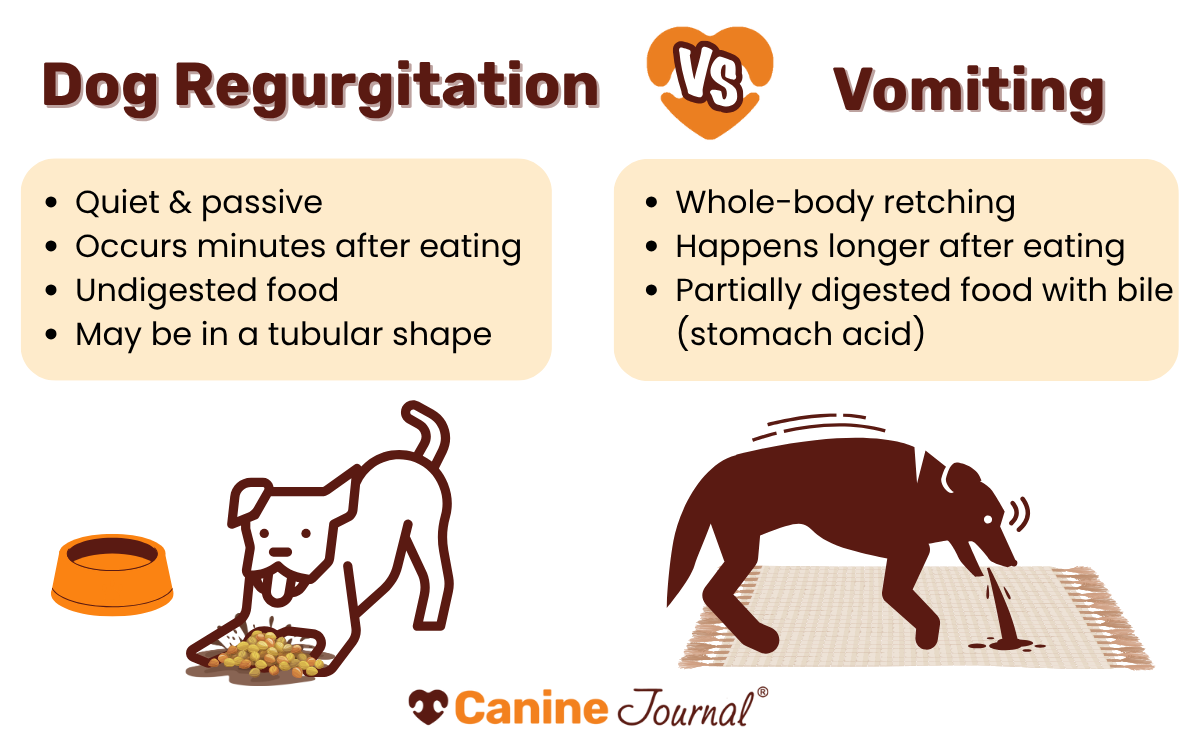
3. Nasal or Sinus Discharge
If the moisture is coming from the nose or appears more slimy than drooly, it could be nasal discharge or postnasal drip. This can happen with:
- Respiratory infections
- Allergies
- Dental infections that extend into the sinuses
If you see thick mucus, blood, or persistent sneezing along with drool, it’s time for a vet visit.
Ask yourself:
- Does it smell sour or metallic?
- Is it thick, bubbly, or tinted?
- Does my dog seem nauseous or congested?
Those details can tell you and your vet whether you’re dealing with simple drool or something that needs attention.
How Can Pet Insurance Help?
Our furry friends are susceptible to so many accidents and illnesses throughout their lives. Treatment and surgery for everything from an intestinal obstruction to a cancer diagnosis can result in thousands of dollars in vet bills.
However, a reasonable monthly premium for pet insurance can cover a significant portion of your vet expenses for emergencies, accidents, and unforeseen illnesses.
You never want to face the decision of sacrificing your dog’s health and well-being because you can’t afford treatment. Check out our comprehensive pet insurance guide to see if it’s a worthy investment for your family.
Dog Drooling a Lot? FAQs Answered
Here are some questions and answers about dog drooling that may be of help to you. If you don’t see your question below, ask us your question in the comments, and we’ll try to find the answer for you.
My Dog Is Drooling And Acting Strange: What Should I Do?
If your dog is suddenly behaving abnormally with or without drooling, you should contact your vet as soon as possible. Our pups can get into all kinds of trouble without us knowing what’s going on.
Your vet is your best resource to understand what may be causing your dog’s strange behavior, coupled with drooling.
What If My Dog Is Suddenly Drooling From One Side Of Their Mouth?
A dog suddenly drooling on one side of their mouth usually indicates a localized issue, such as a damaged tooth or a foreign object lodged in that side of the mouth.
Other reasons could be a bee sting, an insect bite, or a spider bite. Check your pup’s mouth for any problems. If the cause for drooling isn’t clearly evident or you spot a broken tooth, bee sting, or mouth trauma, you should promptly seek veterinary care.
Should I Worry About My Puppy Drooling A Lot?
Puppies drool more than normal when they’re teething, which typically occurs at three to four weeks of age and then again when they’re four to seven months old (but can vary by breed). But puppies can also drool excessively for many of the medical reasons we describe above.
They’re particularly susceptible to intestinal blockage due to their chewing habits. So, it’s important to pay attention to your puppy’s symptoms. When in doubt, seek veterinary care.
Keep Exploring Your Dog’s Health
Drool isn’t always the full story; sometimes it’s just the first clue. The more you understand these everyday signs and see the vet for regular checks, the easier it is to catch problems early, keep your dog comfortable, and avoid surprise vet bills later.
If your dog’s behavior has you wiping floors more than usual, it might be time to look deeper. From unexplained thirst to obsessive paw licking or even bad breath that won’t quit, these small changes can reveal a lot about what’s going on inside your pup’s body.
Tell Us: How Slobbery Does Your Dog Get? Has your dog ever left a puddle on the couch? Does travel, teething, or excitement set off their inner fountain? Share your drool tales (and survival tips) in the comments, because no one understands soggy sleeves like a fellow dog parent.
